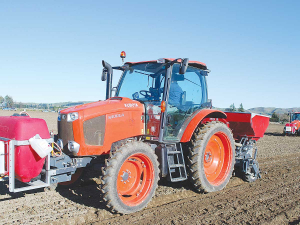Carrfields expands South Island footprint with Agricentre South Kubota dealership acquisition
Two of the South Island’s agricultural machinery dealers are undertaking strategic changes designed to deliver even greater specialist support to farmers.
 Murphy NZ Ltd uses a fleet of five Kubota tractors to do most of the work required to grow the garlic and shallots they produce.
Murphy NZ Ltd uses a fleet of five Kubota tractors to do most of the work required to grow the garlic and shallots they produce.
New Zealand’s largest garlic and shallot producer is finding success with Kubota tractors.
Family-run Murphy NZ Ltd, formally Marlborough Garlic, grow their garlic on leased ground near Darfield and Sheffield in Canterbury, with shallots produced in Marlborough.
“With 95% of output being sold in the domestic market, the chances are if you buy New Zealand garlic in the supermarket, it will be ours,” says field manager Rob Fisher. “Along with fresh garlic and shallots, we sell Garlic Noir – which is slow-cooked and fermented black garlic.”
Fisher says the move south into Canterbury was necessary because it is important to grow garlic in fresh ground.
“We need to change the ground we grow garlic and shallots in every two years as they are susceptible to white rot, so growing them in fresh soil helps to protect the health of the crop.”
Murphy NZ Ltd uses a fleet of five Kubota tractors to do most of the work required to grow the pungent bulbs, made up of a 125-hp Kubota M126GX, two 110-hp Kubota M110GXs, and two older Kubota M95Xs.
“We like Kubota tractors because of their versatility. They give us the ability to easily vary our PTO and ground speeds,” Fisher explains.
“The three-tiered gearbox gives us high, medium and low ranges, with a total of 24 speeds. So, we can always find the right gear for every application, along with enough hydraulic power to do everything we need.”
Local Kubota dealer, Norwood Blenheim installed a Trimble GPS and self-steer system in the two M110GX tractors, that in turn access a satellite based RTK signal to achieve 2cm accuracy. The two M110GX tractors, based in Canterbury, run precision planters and specialist garlic harvesters, exploiting their traits of great manoeuvrability to deliver tight headlands turns.
The larger M126GX and smaller M95Xs are based in Marlborough. The M126GX takes on tasks such as power harrowing, discing and spraying.
These jobs are normally undertaken by contractors in the southern operation.
Equipped with a front-end loader, the M126GX is proving to be user friendly and versatile. It has a cabin that has plenty of room and lots of glass for 360-degree visibility.
“It also has great fuel economy-an important consideration for us, as we grow the shallots in Awatere, which is 45 minutes from the yard,” Fisher says.
Meat processors are hopeful that the additional 15% tariff on lamb exports to the US will also come off.
Fears of a serious early drought in Hawke’s Bay have been allayed – for the moment at least.
There was much theatre in the Beehive before the Government's new Resource Management Act (RMA) reform bills were introduced into Parliament last week.
The government has unveiled yet another move which it claims will unlock the potential of the country’s cities and region.
The government is hailing the news that food and fibre exports are predicted to reach a record $62 billion in the next year.
The final Global Dairy Trade (GDT) auction has delivered bad news for dairy farmers.

OPINION: The release of the Natural Environment Bill and Planning Bill to replace the Resource Management Act is a red-letter day…
OPINION: Federated Farmers has launched a new campaign, swapping ‘The Twelve Days of Christmas’ for ‘The Twelve Pests of Christmas’ to…